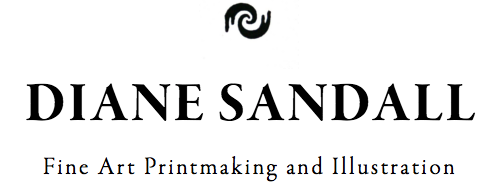The first books printed on Gutenberg's press were variations of relief printmaking. While my press looks much different from those first ones, the underlying principle is much the same. Simply put, a raised surface is inked, then pressed on paper, leaving behind an impression.
Relief printmaking involves carving one’s design into the surface of a block, but the whole process starts with a simple sketch on paper. I work the drawing in progressively greater detail until I see clearly what I want the print to be. All of my prints are individually made, by hand, one by one, starting with the drawing.
The next step is to transfer the drawing onto the surface of either a wood, or linoleum, block. I like working with both materials, but select which block to use based on what kind of print I want to make, what sort of ink I will be using, and how tightly the detail will be carved. Once I have chosen my block, I prepare a reversal of the drawing to trace onto the block with carbon paper. The drawing on the block must always be a mirror image of the original, so once it is turned over and printed, the finished print will have the same orientation as the initial drawing.
If I am working with a single color, I can move on to the next step. If I am working with multiple colors, I go on to prepare a separate block for each color, which will be printed one atop the other in layers. Aligning, or ‘registering,’ multiple blocks precisely is complicated and takes practice, but well worth the effort for a clean, professionally finished print.
After I have transferred the drawing onto the block, I will draw over the lines with permanent ink to make sure I don’t lose any of the details while I am handling the block. When that is done, I am ready to start carving. Extremely sharp, fine-tipped tools make the carving easier, but it is a painstaking process and mistakes cannot be corrected. Despite this, it is my very favorite part.
Sketches, block layout, and carving are all demonstrated here.
When, at last, I think the carving is done, it is time to make the first print. This is my test, or proof print. Within it, I will see all the areas that need to be corrected and lines that need to be cleaned up.
Bit by bit, I fuss until the block is how I want it to be, and am ready to print my edition.
The finished prints hanging to dry.
I use two main techniques to print. One uses oil based inks, and involves running the block through my Swedish proof press. The other is a Japanese technique called moku hanga which uses water based inks that are printed using a hand tool called a baren. Two very different techniques which create very unique effects!
I use only beautiful, acid free papers, to ensure that my prints will withstand the test of time. I typically print small, limited editions, meaning that once I have completed printing an edition, the block is set aside and will not be reprinted. My editions typically number around 15-25 prints. Sometimes the final number of prints in an edition is dependent on the technical challenges the particular print presents. The most refreshing part of printmaking, for me, is that there is no end to the challenges it offers, with ever more exploration available.




